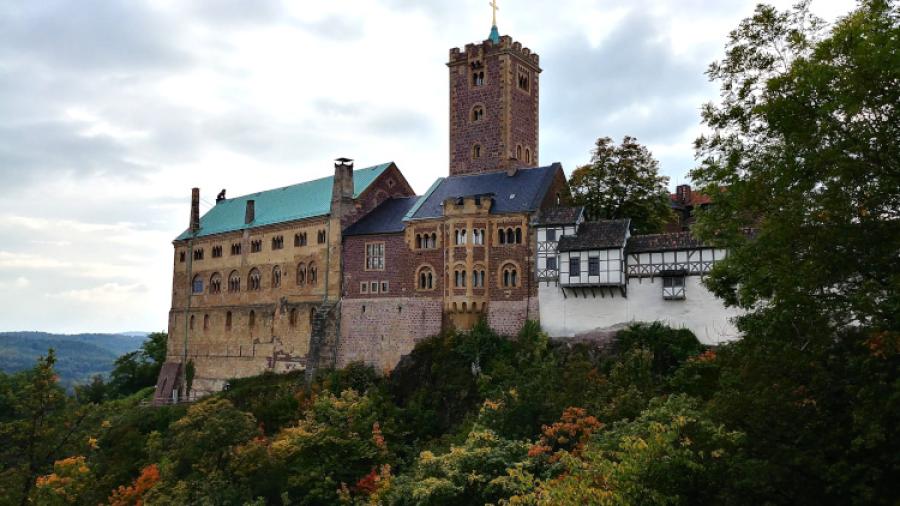After the Darkness, Light
Image

Wartburg Castle
If you had asked me, as a young boy, what holiday we celebrate on October 31, I likely would have responded, “Reformation Day.”
Sure, I was intrigued by ghosts, ghouls and goblins as much as the next kid—but not for their own sake. I, instead, preferred to think of them as the backdrop, set in place by hundreds of years of darkness, against which the light of Reformation shone crystal clear from the Castle Church door in Wittenberg, Germany.
You see, being raised confessional Lutheran, the significance of Luther’s bold act of Reformation on Oct. 31, 1517, was drilled into me from my earliest days. Granted, it was a bit of a cartoonish view of those events that was taught to us as back then as small children. But it stuck in my mind for a lifetime.
By the time I finished Lutheran high school, however, I thought I’d had enough of the Reformation. What I did not realize initially, though, was that my own life was following the very trajectory—in terms of the progressive development of doctrine—that I would later find fascinating in relation to church history.
As I began studying what I would come to understand as dispensational theology, and attending a Bible church, my focus was much more on the future—my own, but also the prophetic future—than the past. I actually minored in social studies in Bible college and had several outstanding history classes, but church history, specifically, was not emphasized overall.
Perhaps that’s where I began to become quite intrigued. There was a gaping hole in my knowledge base, and I wanted to know more. I did not want to be like the proverbial fellow who explained with conviction how D.L. Moody had handed us the King James Bible straight as he received it from the Apostle Paul.
And I was also drawn back to that childhood fascination with the events of the Reformation. I just didn’t know exactly how they fit together with my newfound understanding of Scripture. But, I preached about Reformation Day—and later added the history of the Pilgrims—in the two small Baptist churches that I pastored as a young man. Likely, these were the first times that such subjects had been broached from either of these pulpits. One man even listed my focus on Luther as just cause for his decision to leave the church.
Nonetheless, my inquisitiveness grew. It began to flourish in seminary, where I realized, first of all, how profound my ignorance of church history really was. But Dr. Myron Houghton, in particular, helped me comprehend how I as a seminarian was grasping hold of a long line of tradition that bonded me to churchmen stretching all the way down through the centuries of this church age.
I continued to preach and teach about the Reformation, specifically, as I had opportunity. Then, in September of 2017, Lynnette and I had the incredible privilege of touring Germany for the 500th anniversary of the Reformation. The experience was life-changing.
My understanding of the Reformation is no longer childlike. It is as real as the clay tiles on the roofs in Worms, or the wooden steps in the Wartburg Castle. The lead speaker on our tour, Dr. James White, impressed upon us the necessity of growing out of our comic-book-superhero level of understanding of the people and events that we would be studying. He wanted us to see what happened there—for what it really was.
And yet, the Reformation leaves many unanswered questions with which we must still grapple in our day—and this is especially true for all Baptistic and dispensational Christians.
Specifically, how did our traditions begin to prosper in the decades and centuries following the Reformation? It seems clear to me that the Lord indeed used the Reformation to accelerate these movements—even if the 16th-century Reformers themselves attempted to extinguish them. Men may have “meant evil … but God meant it for good” (Gen. 50:20).
We need real answers to these questions, dealing with the issues of what God and men truly did during these times—rather than what we wish they might have done.
The coming months are, for me, the church history phase of the year—as I look for opportunities to teach the history of the Reformation, up through the time of the Pilgrims, before Thanksgiving. In recent years, I have discovered that the Geneva Bible is one of the critical links in this historical chain, and studying it has also become a passion of mine.
One of the most ancient mottos of the Reformation is the Latin phrase, Post Tenebras Lux—”After the Darkness, Light.” It appears to many that God is now setting the stage for the final great historical period of this age—the 70th week of Daniel (see Dan. 9:24-27), or the tribulation. We may be just about to experience the deepest darkness that the body of Christ has ever felt upon this Earth.
May God help us to seek wisdom from the greatest of His servants who have preceded us—especially those who have previously mastered His methods of overcoming such haunting darkness as we might face.
Paul Scharf 2019 Bio
Paul J. Scharf (M.A., M.Div., Faith Baptist Theological Seminary) is a church ministries representative for The Friends of Israel Gospel Ministry, serving in the midwest. He also assists Whitcomb Ministries and writes for “Answers” Magazine and Regular Baptist Press. For more information on his ministry, visit foi.org/scharf or email pscharf@foi.org.
- 160 views


Discussion